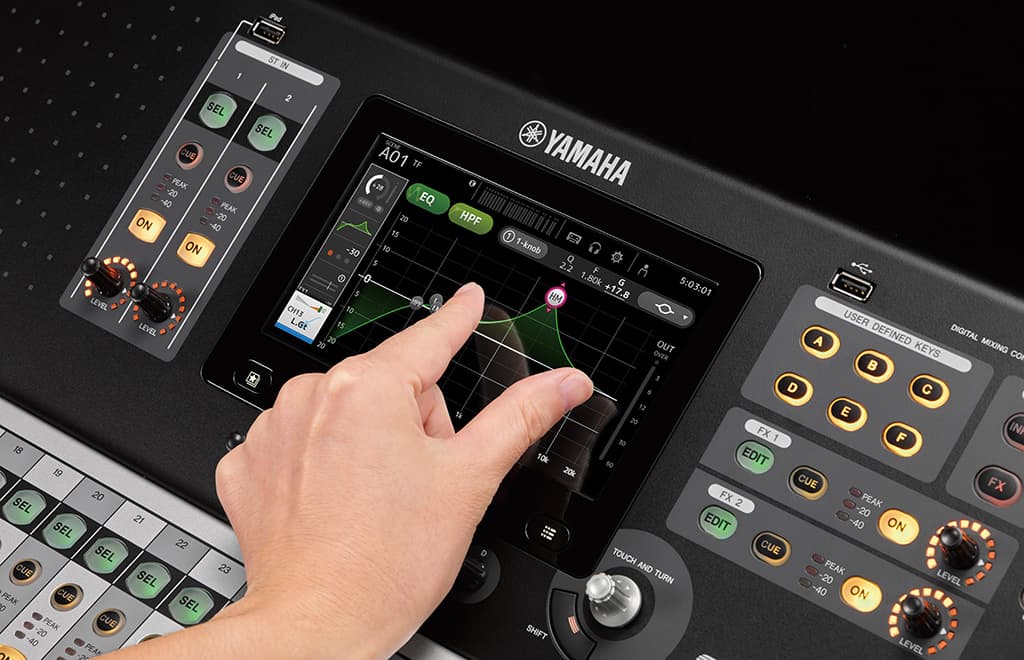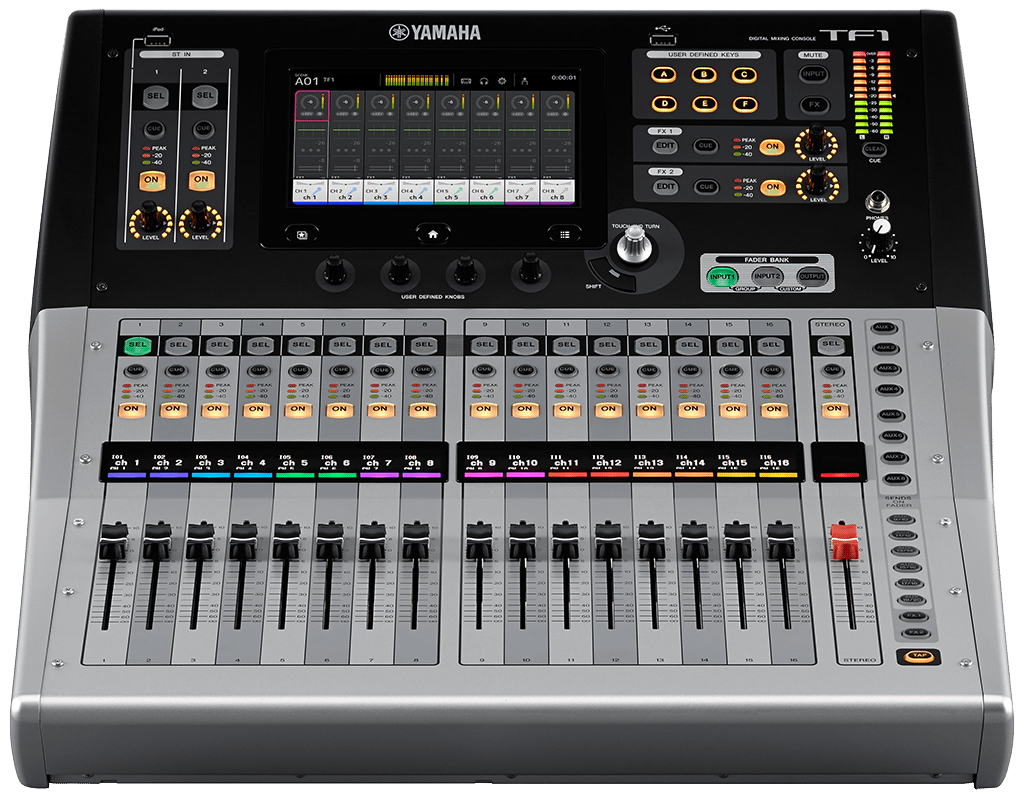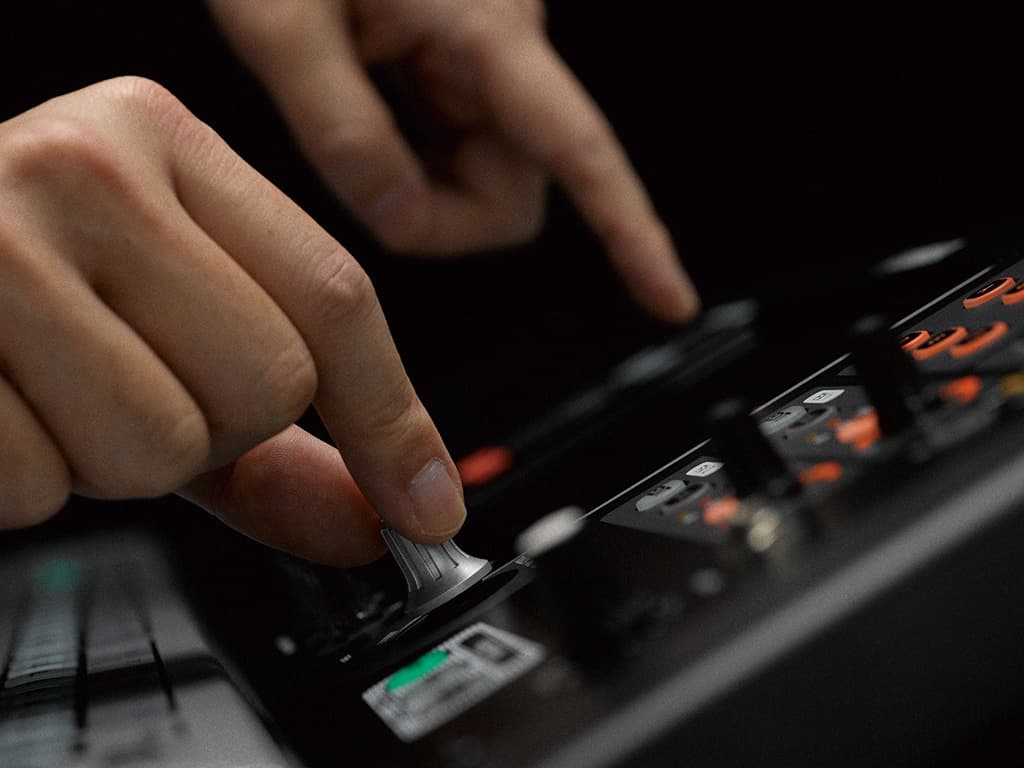
Review: Yamaha TF1
TouchFlow digital mixers are an analogue die-hard's best friend.
They must live for excitement at Yamaha. You can’t help but like a company that makes mixing consoles and motorbikes. I’ve long thought that sense of adventure goes some way to explaining why its serious products combine high-performance, bold design and bullet-proof packaging. Motorbike or a mixing console, you want it to work when it counts and you don’t want it to crash. It’s about the thrill of movement, and the TF series of digital mixers have been purposefully designed for fluid operation. Under the banner of TouchFlow Operation are several concepts that start by making it easy to get going, and finish with a console that fun is to drive at showtime.
Made specifically for live sound, the TF Series is Yamaha’s entry-level digital mixer and it’s aimed squarely at the highly competitive 16-32 channel professional mixer market. It will be used in venues and churches, and by production suppliers and DIY bands. It’s the friendliest digital mixer I’ve tried so far and cleverly designed for the mix of pro and casual users who will get their fingers on the faders.
MAKING GOOD GAINS
The TF1 boots up like an analogue desk with 16 combi XLR inputs on the back panel, two big FX returns and 1:1 routing. You can do all sorts of patching with the Auxes, DCAs and Custom channels… but not with the input channels. Makes sense to me, you may lose a little flexibility but it makes for straight-forward set-ups and reduces the chance of confusion in situations where there are multiple users.
There are several ways to set up channels. It’s easy to start from flat and build up your own settings the old-fashioned way. There are, however, interesting alternatives. GainFinder is a cute program that sets the input gain of any given channel like a guitar tuner; make the sound, get the light in the middle and it will be good to go. Like the guitar tuner you don’t have to understand what you’re doing, just watch the display. It’s fast, safe and could be genuinely helpful in some applications. Best of all, its optional. Input levels can also be set by the Touch & Turn knob or by dragging on the screen.
The more interesting alternative is to use the QuickPro Presets, available on both inputs and outputs. When setting up input channels a handy library lists instrument-specific settings as well as settings for particular microphone models. Yamaha has drummed this feature up in cahoots with a handful of well-known mic manufactures that so far includes Shure, Sennheiser and Audio-Technica. Choose the mic, choose the instrument and you get specific factory-approved Gain, EQ and Comp settings, including phantom power and instrument name on the channel strip — in your choice of colour. If you’re familiar with the particular mics it’s interesting to see what the makers have recommended. If you’re not, it’s a safe option. It’s also a fast way of working as it puts a lot of common processing choices into action at once and I found the settings to be close to what I might do anyway.
Output channels get their own library of generic presets designed for different physical locations, including settings for running IEMs from the stereo aux sends. In a similar manner to the inputs you get EQ and Compressor settings that have been well chosen to get you going quickly without doing anything crazy to the sound. The output presets extend to specific settings for Yamaha DXR speakers in different environments, but third-party speaker manufacturers will no doubt be added over time.
NEED TO KNOW
Yamaha TF1
Digital Live Mixer

TF FOR TOUCHFLOW
In use the TF mixers live up to the TouchFlow promise; the layout gives you instant access to the things you really need, use all the time or you want to access quickly. Focus on the multi-touch screen means less thinking about which button to press, or knob to turn, and more listening. The console can be operated very simply but it’s rewarding to explore the depth of control that is available and it’s hard to get confused or lost.
Most users will be familiar with the Overview/Selected Channel layout common to most digital mixers. Here eight channels are displayed on the Overview screen at one time, but rather than buttons to scroll to the rest, you swipe. Touch a parameter on a channel and the channel is selected, touch again and the parameter details are displayed. After that you may only need to touch and use pinch/drag gestures on the screen to get the sound where you want it. The on-screen parameter controls have got nice big buttons that you touch to activate and drag to adjust. Pinch gestures change the EQ width and everything you do is accompanied by clear visual feedback. Apart from being pleasing to use in the modern mobile phone manner, it means you don’t need the common hardware knobs used to adjust the selected parameters.
Knobs have their uses and after the multi-touch screen the next feature aimed at making life easier is the Touch & Turn knob. Well-placed for easy reach the Touch & Turn knob is a multi-function device that’s assigned by touching parameters onscreen. Touch Input on the Overview screen and it provides instant access to the input gain of any displayed channel. It’s the same routine for grabbing control of selected EQ parameters, HPF, gate/comp thresholds or FX levels. Touch the parameter again and you get to the detailed controls where it adjusts the selected parameter as an alternative to dragging on the screen.
1-KNOB TO TWEAK THEM
You may not need to use the detailed parameter controls at all if you use Yamaha’s new 1-knob EQ and 1-knob Comp functions, both controlled by the Touch & Turn knob. These are activated by the user when you’re setting up a channel, or automatically as part of the QuickPro Presets. Designed again for either speedy operation or users who don’t fully understand the meaning of the parameter values, these effectively give you more when turned up. More what? More everything.
On input channels the 1-knob EQ has two modes, Vocal and Intensity. If you have selected a particular microphone model from the QuickPro Presets then Vocal mode will probably give you a HPF, some low-mid cut and some high-mid boost. Winding up the Touch & Turn knob simultaneously delivers more HPF, more low-mid cut and more presence boost. Or less if you turn it down. You can also draw your own curve and have it exaggerated or understated. It’s clever stuff and very easy to use. Intensity mode is similar but aimed more at instruments. 1-knob EQ also works on the Main and Aux outputs with the Vocal mode being replaced by a Loudness mode that progressively boosts low and hi frequencies while cutting some low-mids.
The 1-knob Comp does the same for channel dynamics. The basic settings are established by the preset; turn it up with the Touch & Turn knob and you get more threshold, more ratio and more make-up gain. The potential for over-processed channels is the risk when a single knob controls several parameters at once but the settings are all valid and there are sensible limits on the amount of boost on hand. Any setting can be changed or removed with a touch on the screen if it’s not to your liking. I didn’t get any nasty surprises when operating.
Motorbike or a mixing console, you want it to work when it counts and you don’t want it to crash


DOUBLE HANDLE — Angled cut-outs on the sides double as visual enhancements and handles.
EFFECTS WITHIN REACH
On-board effects are based on Yamaha’s SPX range and while there are eight FX processors available, the input channels can only directly access two of them at a time. These get dedicated returns on the surface, the rest are accessed via the stereo aux groups. At first this seems a curious setup in the digital age. It’s reminiscent of old analogue desks where you would set up a reverb and a delay from the two available sends, and if you wanted more FX you inserted them across channels or groups.
There are six stereo aux sends in the TF mixers, each with a processor attached. These sends would often be used as part of a monitor setup, particularly for IEMs with, for instance, a multiband compressor across the send. The stereo aux sends can also be used as subgroups and sent to the Master Out, with your choice of effects, or they can be used as purely stereo FX send/returns.
The two main FX returns are kept within hands reach, which keeps the focus on the console surface. A big FX Mute button just above the returns is great for muting your FX between songs. If you know what you’re doing there’s plenty of opportunity to tweak just below the surface, but it’s certainly convenient to be able to control the most commonly used effects without changing layers. A tap button in the bottom corner of the console is in a handy place but I would have liked to be able to stop it flashing the whole time, I’d prefer if it stopped after a few flashes and then started again when you tapped it the next time you needed it.
MONITOR PERFORMANCE
The TF1 is an excellent monitor board, the larger models equally so if you need more input channels. The eight mono aux sends have a compressor plus parametric and graphic EQs in place. I half expected the graphic EQ’s 31 bands to be thrown across the faders but they come up on the screen where you drag the virtual faders to adjust the tone. It’s much simpler to follow and the virtual faders readily return to zero.
The mono aux sends would normally be used to drive stage speakers and they don’t have access to any FX. Good. The six stereo aux sends, complete with FX, should be enough for the IEM or other stereo send requirements of most bands.
The first time I used the TF1 live was doing monitors for Tim Rogers & The Bamboos at the Theatre Royal in Castlemaine and I had a ball. Great band — which always helps the sound — plus Tim’s style and energy made for a pumped-up show. We had seven sends working; the band knew what they wanted, and I found I was able to respond to their requests as fast as they could fire them at me. The Sends On Faders buttons are right at hand, the colour-coded, illuminated channel strip helps you find particular channels quickly, and individual EQ/Comps are always at the ready. For bands willing to forgo the personal touch of a helpful monitor engineer, the TF Monitor mix iOS app allows them to wirelessly control their own levels from a phone or iPad.
It’s the friendliest digital mixer I’ve tried so far and cleverly designed for the mix of pro and casual users who will get their fingers on the faders

FRONT OF BRAIN
As a Front-of-House console, the TF mixers offer an engaging and rewarding experience. I thought the sound quality was great; the recallable D-Pres are transparent, the processing does what you expect and the FX are normal Yamaha quality. What impressed me was the way I could confidently move around the console, listening and adjusting without wearing the brain out by having to think about it too much. The EQ and dynamics processors are so easy to use — from wherever you are on the console — that they allow you to make tweaks instinctively and quickly. The Touch & Turn knob was usually already assigned to the right parameter. I found it made for very active operation. There’s several fader banks, as well as all the aux sends on faders, but not once did I get confused about which layer I was on.
With the FX returns on the topmost layer, most FOH mixing will be done without any layer changing. Both the 1-knob EQ and 1-knob Comp multi-functionality grew on me, particularly on vocals where the 1-knob control of HPF, low-mid EQ and a touch of presence gave good control of the proximity effect, body and bite in one action.
The TF mixers are live boards and their record/playback capabilities are designed with live recording in mind. A USB socket allows for stereo playback (.wav and .mp3) or direct stereo recording from any output bus. Another USB port connects to a computer, and with the included Cubase AI software installed it’s possible to record/playback up to 16 channels of 24-bit/48k audio. Up to 34 channels can be accessed via most other DAWs. Recorded shows or rehearsals can be played back in a different location and channels can be freely switched between live and playback for virtual sound checks. The TF StageMix iPad app allows for wireless control of the mixer enabling remote mixing or monitor set-up.

MORE LAYERS TO COME
The TF series is brand new and some pieces are still falling into place. At the time of writing the second fader layer is not being fully utilized. With some soon-to-be-released add-ons and revised firmware it will be possible to use the NY64-D expansion card in conjunction with the Tio1608-D Dante equipped 16-in/8-out stage rack. Connection is via a convenient CAT5e LAN cable. The preamps in the Tio 1608-D can be remotely controlled from the TF mixer and up to three three of these can be connected at the same time to create a 48-in/24-out system. Software updates will include more settings from microphone manufacturers. Speakers can especially benefit from specific settings for different uses/placements and this is another area that will grow.
Yamaha continues to chase quality and push design boundaries with enthusiasm. Designed to provide a rewarding experience to a wide range of users the TF Series sets a high standard for an entry-level pro mixer with technology that’s right up to date. TouchFlow operation facilitates engaged, active mixing with a sense of playing, or driving, the console. The multi-touch screen is command central and the first in this price range to use one. I grew up on early Yamaha analogue consoles and have several of them in my shed. I bet they still work too. It’s an open question as to whether the current breed of digital consoles will still be working in 35 years but if any will, they’ll be the Yamahas. Where the development of digital audio technology will lead over that time is less certain… a USB socket in the back of the head perhaps, so we can simply think the sound. But for right now the TF series will do nicely.
















You say the mono AUX sends have no access to fx. Does that mean you can’t send a bit of reverb to the performer? You say good, I say that seems like a huge oversight especially for a desk to be used with diy musicians/bands. I know plenty of singers that appreciate a bit of effects return intro their monitor. I hope I’m mistaken lol.
Hi Damien, what Mark is referring to is the lack of FX on the mono aux sends — which is why you’d use these for mono applications like stage speakers i.e. foldback monitors. The stereo sends, which are equipped with FX, should be used for stereo monitoring applications e.g. in-ear monitors. But you can of course allow performers to hear effects (reverb, delay etc.) in their mono stage fold backs by turning up the stereo effects return fader in the appropriate mono send mix.
can i insert the multi band compressor to input channel?